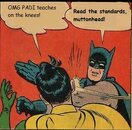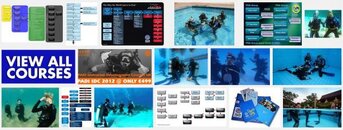You are using an out of date browser. It may not display this or other websites correctly.
You should upgrade or use an alternative browser.
You should upgrade or use an alternative browser.
A picture is worth a 1000 words
- Thread starter Diver0001
- Start date
Please register or login
Welcome to ScubaBoard, the world's largest scuba diving community. Registration is not required to read the forums, but we encourage you to join. Joining has its benefits and enables you to participate in the discussions.
Benefits of registering include
- Ability to post and comment on topics and discussions.
- A Free photo gallery to share your dive photos with the world.
- You can make this box go away
DevonDiver
N/A
Just do a Google Image search for "PADI Class"... there's a 1000 images, that each speak a 1000 words... 
See, Andy didn't read the standards either. 
Don't confuse some instructors' delivery with what the standards say.
Some instructors choose to teach on the knees. What PADI actually says about it is this: "conduct as much of the training as possible while students are neutrally buoyant (rather than sitting on the bottom)".
Go ahead and open up the standards and search for the word "knees". The word "knees" does not appear in the standards. Not once.
R..
Don't confuse some instructors' delivery with what the standards say.
Some instructors choose to teach on the knees. What PADI actually says about it is this: "conduct as much of the training as possible while students are neutrally buoyant (rather than sitting on the bottom)".
Go ahead and open up the standards and search for the word "knees". The word "knees" does not appear in the standards. Not once.
R..
Oh and if you actually do Google "PADI training", you'll see, in addition to the images that Andy would have you believe are the only ones you'll find, things like this:
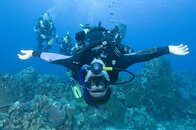
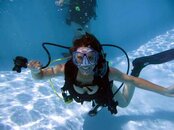
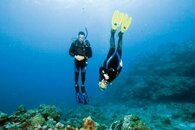
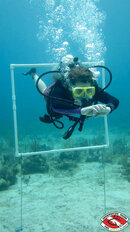
People can choose to be cynical if they want, but cynicism gives a person an excuse not to be a part of the solution. Yes, some instructors deliver poor quality courses, but let's get the facts out there... namely that it's the instructor whose chooses to teach in that manner.
I also hope that people who are thinking about taking a course and encounter this thread will be triggered to ask how the course is conducted (or better yet, to audit a session) so they can make an informed decision about their instruction.
The point is that we often hear "it's about the instructor" and that's really true.
R..




People can choose to be cynical if they want, but cynicism gives a person an excuse not to be a part of the solution. Yes, some instructors deliver poor quality courses, but let's get the facts out there... namely that it's the instructor whose chooses to teach in that manner.
I also hope that people who are thinking about taking a course and encounter this thread will be triggered to ask how the course is conducted (or better yet, to audit a session) so they can make an informed decision about their instruction.
The point is that we often hear "it's about the instructor" and that's really true.
R..
DevonDiver
N/A
See, Andy didn't read the standards either.
Don't confuse some instructors' delivery with what the standards say.
The standards don't have any pictures in them (but the manuals do...).
As you said... pictures speak a 1000 words.. wasn't that your point?
Not that I'm arguing that the PADI standards can't be interpreted in numerous ways. The 'PADI Guide to Teaching', for instance, specifically states/recommends several confined water skills to be conducted on the knees.
What we see with PADI is not a standards issue, per say, but rather an organisational culture. The vast majority (yes, vast) of instructors teach most confined water, and many open water, skills from a negative, kneeling position.
Soon to be globally implemented changes to the PADI Open Water standards may address this - as they specify a greater focus upon neutral buoyancy training. Though they are still open to interpretation (i.e. nothing 'wrong' with remaining on the knees) and there will be some magnificent inertia amongst the (vast majority) of instructors/schools to making such a fundamental transition in approach...
---------- Post added November 28th, 2013 at 07:51 PM ----------
Oh and if you actually do Google "PADI training", you'll see, in addition to the images that Andy would have you believe are the only ones you'll find, things like this:
View attachment 172046View attachment 172047View attachment 172048View attachment 172049
None of which are Open Water students/classes... correct?
DevonDiver
N/A
Hmmm... Google must give different results depending on your frame of mind. 
Here's another picture that describes this discussion:
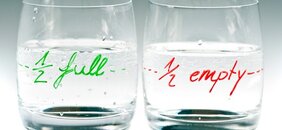
As I said above, standards and delivery are separate issues. In all these discussions people confuse the two.
Some people will be able to see the opportunities that standards offer to run excellent courses and they will work at delivering excellence. Others will be unable to look past perceived failures and will somehow convince themselves that pessimism will lead others to excellence.
I didn't start this thread for no reason, of course. PADI wants instructors to start teaching a new way. The standards have been adjusted and the bar raised, but many instructors will hold on to old habits or will convince themselves that what PADI wants isn't possible. They'll point to the same pictures you did and say, "see, everyone is doing it like this." It will be their justification for not trying to make the improvement.
In my mind it doesn't help when fellow instructors, ones who should know the difference, ones who are passionate enough to be deeply engaged in places like Scubaboard, are also pointing to those same pictures and claiming that this is reality. Of course, the pessimist always THINKS he is the realist, despite the obvious facts.
In reality PADI never did mandate this style of teaching. The accepted it, but they never mandated it. Now they have put a new paradigm out and they're saying that they specifically DO NOT want it. A new reality is coming, and some of our colleagues are going to need leadership to bootstrap themselves to that bar. Some here on Scubaboard have been busy with it for a couple of years but we're going to need as many people on board as we can get in order to help our colleagues to start teaching scuba diving the way it was intended to be taught.
For that, we must first accept that the opportunity is there, to look ahead and to view the potential in this change with optimism. No worthwhile achievement was ever born out of pessimism and staring blindly at past mistakes.
So getting back to the first post, the standards are clear. Now it's time to let go of the cynicism and get to work.
R..
Here's another picture that describes this discussion:

As I said above, standards and delivery are separate issues. In all these discussions people confuse the two.
Some people will be able to see the opportunities that standards offer to run excellent courses and they will work at delivering excellence. Others will be unable to look past perceived failures and will somehow convince themselves that pessimism will lead others to excellence.
I didn't start this thread for no reason, of course. PADI wants instructors to start teaching a new way. The standards have been adjusted and the bar raised, but many instructors will hold on to old habits or will convince themselves that what PADI wants isn't possible. They'll point to the same pictures you did and say, "see, everyone is doing it like this." It will be their justification for not trying to make the improvement.
In my mind it doesn't help when fellow instructors, ones who should know the difference, ones who are passionate enough to be deeply engaged in places like Scubaboard, are also pointing to those same pictures and claiming that this is reality. Of course, the pessimist always THINKS he is the realist, despite the obvious facts.
In reality PADI never did mandate this style of teaching. The accepted it, but they never mandated it. Now they have put a new paradigm out and they're saying that they specifically DO NOT want it. A new reality is coming, and some of our colleagues are going to need leadership to bootstrap themselves to that bar. Some here on Scubaboard have been busy with it for a couple of years but we're going to need as many people on board as we can get in order to help our colleagues to start teaching scuba diving the way it was intended to be taught.
For that, we must first accept that the opportunity is there, to look ahead and to view the potential in this change with optimism. No worthwhile achievement was ever born out of pessimism and staring blindly at past mistakes.
So getting back to the first post, the standards are clear. Now it's time to let go of the cynicism and get to work.
R..
DevonDiver
N/A
PADI wants instructors to start teaching a new way. The standards have been adjusted and the bar raised, but many instructors will hold on to old habits or will convince themselves that what PADI wants isn't possible. They'll point to the same pictures you did and say, "see, everyone is doing it like this." It will be their justification for not trying to make the improvement.
That entirely depends on the wording of the standards. If they are unequivocal and state "In neutral buoyancy, making no contact with the bottom, you should......." then the standards enforce the change. Not adhering to them would be a QA issue, and could/would result in suspension or expulsion.
However, If they are vague, optional and open to gross interpretation, then they will do little to overcome inertia. They will display little determination to effect real change from PADI.
How are those standards worded exactly?
- Messages
- 93,337
- Reaction score
- 91,458
- Location
- On the Fun Side of Trump's Wall
- # of dives
- 2500 - 4999
... it ain't a PADI thing ... most of the agencies promote kneeling while training. Heck, I've even seen pictures of "tech" divers kneeling in a circle while training.
Then there's "Dive Training" magazine ... which would have you believe that you walk on the bottom while navigating ...
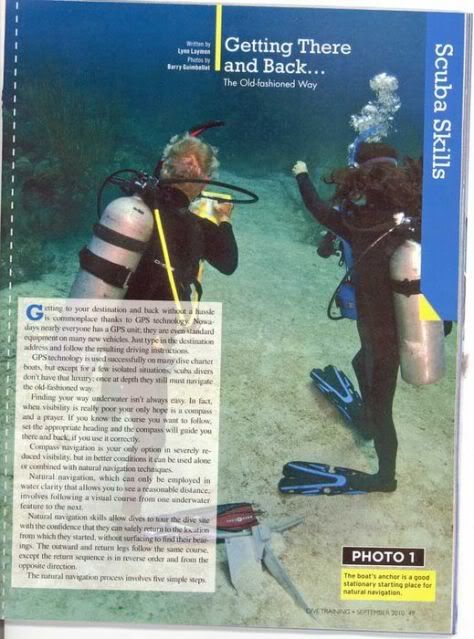
... there's 1000 words they never should have said ...
... Bob (Grateful Diver)
Then there's "Dive Training" magazine ... which would have you believe that you walk on the bottom while navigating ...

... there's 1000 words they never should have said ...
... Bob (Grateful Diver)
Similar threads
- Replies
- 0
- Views
- 474
- Replies
- 13
- Views
- 785
- Replies
- 8
- Views
- 841
- Replies
- 49
- Views
- 6,953




